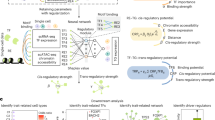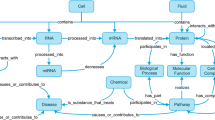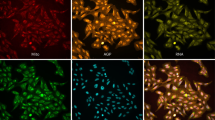Abstract
Genome-scale human protein–protein interaction networks are critical to understanding cell biology and interpreting genomic data, but challenging to produce experimentally. Through data integration and quality control, we provide a scored human protein–protein interaction network (InWeb_InBioMap, or InWeb_IM) with severalfold more interactions (>500,000) and better functional biological relevance than comparable resources. We illustrate that InWeb_InBioMap enables functional interpretation of >4,700 cancer genomes and genes involved in autism.
This is a preview of subscription content, access via your institution
Access options
Subscribe to this journal
Receive 12 print issues and online access
$259.00 per year
only $21.58 per issue
Buy this article
- Purchase on Springer Link
- Instant access to full article PDF
Prices may be subject to local taxes which are calculated during checkout


Similar content being viewed by others
References
Huttlin, E.L. et al. Cell 162, 425–440 (2015).
Hein, M.Y. et al. Cell 163, 712–723 (2015).
Lage, K. Biochim. Biophys. Acta 1842, 1971–1980 (2014).
Venkatesan, K. et al. Nat. Methods 6, 83–90 (2009).
Stumpf, M.P. et al. Proc. Natl. Acad. Sci. USA 105, 6959–6964 (2008).
Jensen, L.J. & Bork, P. Science 322, 56–57 (2008).
Neale, B.M. et al. Nature 485, 242–245 (2012).
Lundby, A. et al. Nat. Methods 11, 868–874 (2014).
Jostins, L. et al. Nature 491, 119–124 (2012).
Okada, Y. et al. Nature 506, 376–381 (2014).
Morris, A.P. et al. Nat. Genet. 44, 981–990 (2012).
Zack, T.I. et al. Nat. Genet. 45, 1134–1140 (2013).
Khurana, E. et al. Science 342, 1235587 (2013).
Rosenbluh, J. et al. Cell Syst. 3, 302–316 (2016).
Brown, K.R. & Jurisica, I. Bioinformatics 21, 2076–2082 (2005).
Brown, K.R. & Jurisica, I. Genome Biol. 8, R95 (2007).
Calderone, A., Castagnoli, L. & Cesareni, G. Nat. Methods 10, 690–691 (2013).
Razick, S., Magklaras, G. & Donaldson, I.M. BMC Bioinformatics 9, 405 (2008).
Cowley, M.J. et al. Nucleic Acids Res. 40, D862–D865 (2012).
Das, J. & Yu, H. BMC Syst. Biol. 6, 92 (2012).
Kotlyar, M., Pastrello, C., Sheahan, N. & Jurisica, I. Nucleic Acids Res. 44, D536–D541 (2016).
Lawrence, M.S. et al. Nature 505, 495–501 (2014).
Sanders, S.J. et al. Neuron 87, 1215–1233 (2015).
Szklarczyk, D. et al. Nucleic Acids Res. 43, D447–D452 (2015).
Kamburov, A., Stelzl, U., Lehrach, H. & Herwig, R. Nucleic Acids Res. 41, D793–D800 (2013).
Lee, I., Blom, U.M., Wang, P.I., Shim, J.E. & Marcotte, E.M. Genome Res. 21, 1109–1121 (2011).
Lage, K. et al. Nat. Biotechnol. 25, 309–316 (2007).
Bader, G.D., Betel, D. & Hogue, C.W. Nucleic Acids Res. 31, 248–250 (2003).
Stark, C. et al. Nucleic Acids Res. 34, D535–D539 (2006).
Xenarios, I. et al. Nucleic Acids Res. 30, 303–305 (2002).
Orchard, S. et al. Nucleic Acids Res. 42, D358–D363 (2014).
Launay, G., Salza, R., Multedo, D., Thierry-Mieg, N. & Ricard-Blum, S. Nucleic Acids Res. 43, D321–D327 (2015).
Kandasamy, K. et al. Genome Biol. 11, R3 (2010).
Croft, D. et al. Nucleic Acids Res. also available from (2014).
Kutmon, M. et al. Nucleic Acids Res. 44, D488–D494 (2016).
UniProt Consortium. Nucleic Acids Res. 43, D204–D212 (2015).
Salwinski, L. et al. Nat. Methods 6, 860–861 (2009).
Powell, S. et al. Nucleic Acids Res. 42, D231–D239 (2014).
Cunningham, F. et al. Nucleic Acids Res. 43, D662–D669 (2015).
NCBI Resource Coordinators. Nucleic Acids Res. 43, D6–D17 (2015).
Sonnhammer, E.L. & Östlund, G. Nucleic Acids Res. 43, D234–D239 (2015).
Brown, G.R. et al. Nucleic Acids Res. 43, D36–D42 (2015).
Kriventseva, E.V. et al. Nucleic Acids Res. 43, D250–D256 (2015).
Kanehisa, M., Sato, Y., Kawashima, M., Furumichi, M. & Tanabe, M. Nucleic Acids Res. 44, D457–D462 (2016).
Penel, S. et al. BMC Bioinformatics 10 (Suppl. 6), S3 (2009).
Acknowledgements
The authors would like to thank L. Wich for developing the graphical user interface for InWeb_IM at https://www.intomics.com/inbio/map. K.L. and H.H. are supported by grant 1P01HD068250, and H.H. is supported by a Fund for Medical Discovery Award from the Executive Committee on Research of Massachusetts General Hospital (project period 02/01/2015-01/31/2016). T.L., H.H., J.M. and K.L. are supported by a grant from the Stanley Center at the Broad Institute of MIT and Harvard (PI: K.L.), a Broadnext10 Grant from the Broad Institute of MIT and Harvard (PI: K.L.), grant 1R01MH109903 from the NIMH (PI: K.L.) and a grant from the Lundbeck Foundation (PI: K.L.). S.B. acknowledges funding from the Novo Nordisk Foundation (grant agreement NNF14CC0001).
Author information
Authors and Affiliations
Contributions
R.W., R.B.H. and T.S.J. developed the computational framework and continue to maintain InWeb_IM. T.L. led and executed the benchmarking analyses and network comparisons with input from R.W., R.B.H., H.H. and J.M. and supervision by K.L., T.L., R.W., R.B.H., H.H., J.M., G.S., C.T.W., O.R., K.R., H.H.S., S.B., T.S.J. and K.L. analyzed data. T.L., R.W., R.B.H., T.S. and K.L. wrote manuscript with input from all authors. K.L. initiated, designed, and led the study.
Corresponding authors
Ethics declarations
Competing interests
R.W., R.B.H. and T.S.J. are employees of Intomics A/S. K.L., S.B., T.S.J. and R.W. are on the scientific advisory board and founders of Intomics A/S with equity in the company. InWeb_IM is a product of Intomics A/S that is freely available to academic users from http://lagelab.org/resources and http://www.intomics.com/inbio/map.
Integrated supplementary information
Supplementary Figure 1 The computational framework leading to InWeb_IM.
Details can be seen using the Adobe Zoom Tool and in Text, Figures, and Supplementary Notes as indicated. InWeb_IM is available from https://www.intomics.com/inbiomap and http://www.lagelab.org/resources/ Moreover, the data is accessible from a graphical user interface https://www.intomics.com/inbiomap and http://apps.broadinstitute.org/genets#InWeb_InBiomap so that it can be interactively explored by any individual researcher who wishes to study the interactions of proteins of interest.
Supplementary Figure 2 Tissue-specific interaction counts.
Networks are indicated on the x axis and interactions between proteins in which the corresponding genes are involved in a tissue-specific expression quantitative trait locus on the y axis. The analysis is made for 27 tissues as indicated on the top of each panel.
Supplementary Figure 3 Proteins covered by tissue-specific interactions.
Networks are indicated on the x axis and proteins that have at least one interaction to another protein with a similar tissue-specific expression quantitative trait locus on the y axis. The analysis is made for 27 tissues as indicated on the top of each panel.
Supplementary Figure 4 Tissue-specific interactions across networks in InWeb_IM compared to other networks.
The x-axis represents the 27 different tissue types from GTEx and the y-axis shows the amount of data in InWeb_IM compared to other networks. Light blue bars denote the values for the amount interactions in the next-largest network, dark blue bars denote the values for the amount of proteins covered by data in the network with the next highest count, light green denotes the values for the median amount of interactions across all five comparable networks, and dark green denotes the values for the median amount of proteins covered by interactions across all five comparable networks.
Supplementary Figure 5 The AUCs derived from applying NMB in autism.
The AUC observed in the network denoted on the x axis is indicated with the blue diamonds (InWeb_IM = 0.65, I2D = 0.58, Mentha = 0.61, iRefIndex = 0.63, PINA = 0.59, HINT = 0.66). The null distribution of AUCs of 120 matched random sets is shown with box whiskers plots. Of these AUCs only the one of InWeb_IM is significant at the Adj. P < 0.05 level.
Supplementary information
Supplementary Text and Figures
Supplementary Figures 1–6 and Supplementary Notes 1–13. (PDF 2066 kb)
Supplementary Table 1
Information on the raw data leading to InWeb_InBioMap (XLSX 21 kb)
Supplementary Table 2
The AUCs of NMB on 17 tumor types for each network (XLSX 36 kb)
Source data
Rights and permissions
About this article
Cite this article
Li, T., Wernersson, R., Hansen, R. et al. A scored human protein–protein interaction network to catalyze genomic interpretation. Nat Methods 14, 61–64 (2017). https://doi.org/10.1038/nmeth.4083
Received:
Accepted:
Published:
Issue Date:
DOI: https://doi.org/10.1038/nmeth.4083
This article is cited by
-
SIRPB1 regulates inflammatory factor expression in the glioma microenvironment via SYK: functional and bioinformatics insights
Journal of Translational Medicine (2024)
-
Disease clusters subsequent to anxiety and stress-related disorders and their genetic determinants
Nature Communications (2024)
-
Protein interaction networks in the vasculature prioritize genes and pathways underlying coronary artery disease
Communications Biology (2024)
-
MCSdb, a database of proteins residing in membrane contact sites
Scientific Data (2024)
-
Identification of important gene signatures in schizophrenia through feature fusion and genetic algorithm
Mammalian Genome (2024)



